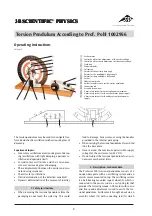
Planetary Features Chart
The Planetary Features Chart provides some basic information about the planets, including their
order, distance from the sun, size, and temperature.
Planet Riddles
Use the Planetary Features Chart to help you solve these planet riddles!
3
Venu
s
Venu
s
Jupi
ter
Mer
cur
y and V
enu
s
Ura
nus
and
Nep
tune
Planet
Symbol
Position
relative
to sun
Average
distance
from sun
Diameter
at equator
“Year”: Period
of time to
orbit sun
Average
orbital
speed
“Day”: Time
it takes to
rotate on
axis
Atmosphere
(major
components)
Moons*
Temperature
(min to max surface temperature
for inner planets; effective
temperature for outer planets)
Mercury
1st
36,000,000 mi
(58,000,000 km)
3,032 mi
(4,879 km)
88 Earth days
30 mi/sec
(48 km/sec)
59 Earth days
almost non-existent
0
-279 to 801 ºF (-173 to 427 ºC)
Venus
2nd
67,000,000 mi
(108,000,000 km)
7,521 mi
(12,104 km)
225 Earth days
22 mi/sec
(35 km/sec)
243 Earth days
carbon dioxide,
nitrogen, and
clouds of sulfuric
acid
0
864 ºF (462 ºC)
Earth
3rd
93,000,000 mi
(150,000,000 km)
7,918 mi
(12,742 km)
365.25 Earth days
18.5 mi/sec
(30 km/sec)
24 hours
78% nitrogen, 21%
oxygen, 1% argon,
carbon dioxide,
and trace gases
1
-126 to 136 ºF (-88 to 58 ºC)
Mars
4th
142,000,000 mi
(228,000,000 km)
4,212 mi
(6,779 km)
687 Earth days
(1.88 Earth years)
15 mi/sec
(24 km/sec)
25 hours
carbon dioxide,
nitrogen, argon
2
-225 to +70 ºF (-153 to +20 ºC)
Jupiter
5th
484,000,000 mi
(778,000,000 km)
88,881 mi
(139,822
km)
11.8 Earth years
8 mi/sec
(13 km/sec)
10 hours
hydrogen, helium
67
-234 ºF (-148 ºC)
Saturn
6th
886,000,000 mi
(1,427,000,000 km)
72,367 mi
(116,464
km)
29.5 Earth years
6 mi/sec
(10 km/sec)
11 hours
hydrogen, helium
62
-288 ºF (-178 ºC)
Uranus
7th
1,784,000,000 mi
(2,871,000,000 km)
31,518 mi
(50,724 km)
84 Earth years
4 mi/sec
(7 km/sec)
17 hours
hydrogen, helium,
methane
27
-357 ºF (-216 ºC)
Neptune
8th
2,795,000,000 mi
4,498,000,000 km)
30,599 mi
(49,244 km)
164 Earth years
3 mi/sec
(5 km/sec)
16 hours
hydrogen, helium,
methane
14
-353 ºF (-214 ºC)
* Scientists are constantly discovering new planetary moons and space objects. For the most up-to-date information, check one of NASA’s websites such as: https://
solarsystem.nasa.gov.
My “day” is longer than my
“year”! Who am I?
I am the biggest planet.
I am so big that all the
other planets could fit
inside of me. Who am I?
The methane gas in our
atmosphere gives us a blue tint.
Which two planets are we?
We are the only two planets in
the solar system without any
moons at all. Who are we?
I am the hottest planet. My
surface temperatures are so hot
that metals like lead would turn
into puddles. Who am I?
2
The Solar System Model
Turn on the model and dim the room lights. You’ll be able to see the sun’s light shining
on the planets better in a darkened room. The support rods and tower will also blend into
the background.
Solar System Basics
•
The sun is at the center of our solar system. It gives us heat and light.
•
Earth is one of 8 planets in our solar system.
•
The inner planets (Mercury, Venus, Earth, Mars) are made of rocks and metals; they are the
“terrestrial planets.”
•
The outer planets (Jupiter, Saturn, Uranus, Neptune) are made mostly of gases, liquid, and
ice; these are the “gas giants.”
•
The planets move, or revolve, around the sun constantly.
•
The planets move in patterns called orbits. The shape of an orbit is not perfectly circular but
like a slightly squished circle.
•
All the planets move in the same direction and on the same plane (“slice of space”) as they
orbit the sun.
•
One “year” is the time it takes a planet to orbit the sun.
•
Each planet also rotates, or spins, as it revolves around the sun.
•
One “day” is the time it takes a planet to rotate all the way around.
•
The planets travel around the sun at different speeds. (In this model, the inner planets move
faster as a group, while the outer planets move more slowly as a group.)
•
The planets follow very regular patterns as they travel around the sun. A planet’s location
changes from day to day, but scientists can calculate where each planet will be at any given
time using mathematics.
Model Not to Scale
Keep in mind that home or classroom solar system models cannot show planet sizes or distances
to scale. This means that the planets’ sizes and distances relative to one another are not what
they would be in real life.
For example, the sun must be shown much smaller, compared to the planets, than it actually is.
In reality, the sun is about 108 times the Earth’s diameter and is about 1 million times greater in
volume—a million Earths could fit inside the sun!
The distance between planets is also hard to show on a model. In reality, the planets are very
small compared to the distances between them. Suppose, for example, our model-sized Neptune
were shown a correct relative distance from the sun (which would be huge if shown to scale—
about 28 inches in diameter, or about as big as an adult bicycle tire). Neptune would need to be
1.4 miles (2322 meters) away. It would take you around a half hour to walk from the sun to the
edge of your solar system model!



















